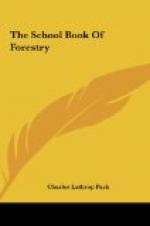Forest insects and tree diseases occasion heavy losses each year among the standing marketable trees. Insects cause a total loss of more than $100,000,000 annually to the forest products of the United States. A great number of destructive insects are constantly at work in the forests injuring or killing live trees or else attacking dead timber. Forest weevils kill tree seeds and destroy the young shoots on trees. Bark and timber beetles bore into and girdle trees and destroy the wood. Many borers and timber worms infest logs and lumber after they are cut and before they are removed from the forest. This scattered work of the insects here, there, and everywhere throughout the forests causes great damage.
Different kinds of flies and moths deposit their eggs on the leaves of the trees. After the eggs hatch, the baby caterpillars feed on the tender, juicy leaves. Some of the bugs destroy all the leaves and thus remove an important means which the tree has of getting food and drink. Wire worms attack the roots of the tree. Leaf hoppers suck on the sap supply of the leaves. Leaf rollers cause the leaves to curl up and die. Trees injured by fire fall easy prey before the attacks of forest insects. It takes a healthy, sturdy tree to escape injury by these pirates of the forests. There are more than five hundred insects that attack oak trees and at least two hundred and fifty different species that carry on destruction among the pines.
Insect pests have worked so actively that many forests have lost practically all their best trees of certain species. Quantities of the largest spruce trees in the Adirondacks have been killed off by bark beetles. The saw-fly worm has killed off most of the mature larches in these eastern forests. As they travel over the National and State Forests, the rangers are always on the watch for signs of tree infection. Whenever they notice red-brown masses of pitch and sawdust on the bark of the trees, they know that insects are busy there. Where the needles of a pine or spruce turn yellow or red, the presence of bark beetles is shown. Signs of pitch on the bark of coniferous trees are the first symptoms of infection. These beetles bore through the bark and into the wood. There they lay eggs. The parent beetles soon die but their children continue the work of burrowing in the wood. Finally, they kill the tree by making a complete cut around the trunk through the layers of wood that act as waiters to carry the food from the roots to the trunk, branches and leaves. The next spring these young develop into full-grown beetles, and come out from the diseased tree. They then attack new trees.




